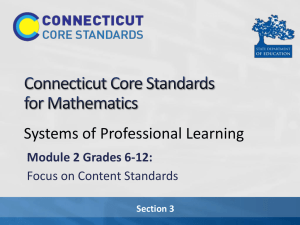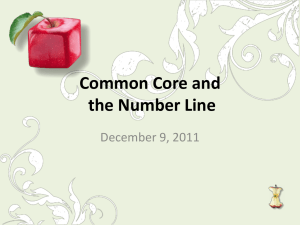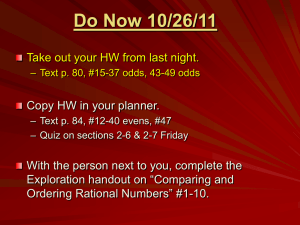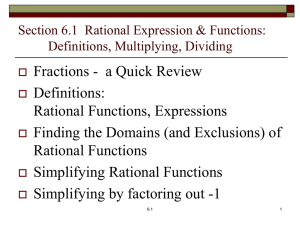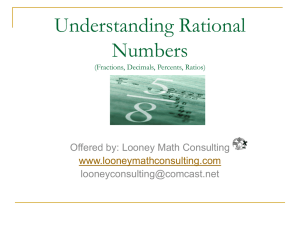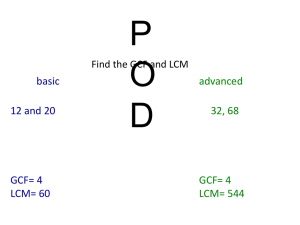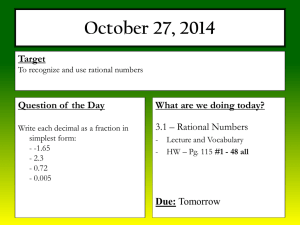High School Fractions
advertisement
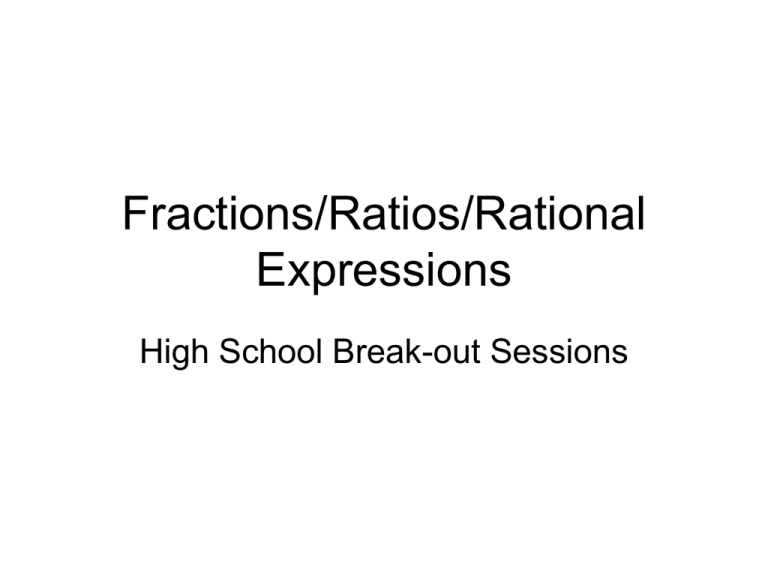
Fractions/Ratios/Rational Expressions High School Break-out Sessions Quick diversion before we start… QuickTime™ and a decompressor are needed to see this picture. High School Break Out Session Overview Standards on Fractions/Ratios/Rational Expressions • What’s in the K-8 Standards? – Progression based on Critical Areas • A look 9-12. What and “where” are the standards • Discussion on specific standards / sample problems and activities to get students thinking deeply K-8 Standards • Standards Handout • Critical areas in the Framework at the elementary grades. K-8 Standards Grade 3 Critical Area #2 Students develop an understanding of fractions, beginning with unit fractions, and they use fractions along with visual fraction models to represent parts of a whole. Students understand that the size of a fractional part is relative to the size of the whole. For example, 1/2 of the paint in a small bucket could be less than 1/3 of the paint in a larger bucket, but 1/3 of a ribbon is longer than 1/5 of the same ribbon because when the ribbon is divided into 3 equal parts, the parts are longer than when divided into 5 equal parts. Students are able to use fractions to represent numbers equal to, less than, and greater than one. They solve problems that involve comparing fractions by using visual models and strategies based on noticing equal numerators and denominators. K-8 Standards Grade 4 Critical Area #2 Students develop understanding of fraction equivalence and operations with fractions. They recognize that two different fractions can be equal (e.g., 15/9 = 5/3), and they develop methods for generating and recognizing equivalent fractions. Students extend previous understandings about how fractions are built from unit fractions, composing fractions from unit fractions, decomposing fractions into unit fractions, and using the meaning of fractions and the meaning of multiplication to multiply a fraction by a whole number. K-8 Standards Grade 5 Critical Area #1 Students apply their understanding of fractions and fraction models to represent the addition and subtraction of fractions with unlike denominators as equivalent calculations with like denominators. They develop fluency in calculating sums and differences of fractions, and make reasonable estimates of them. Students also use the meaning of fractions, of multiplication and division, and the relationship between multiplication and division to understand and explain why the procedures for multiplying and dividing fractions make sense. (Note: this is limited to the case of dividing unit fractions by whole numbers and whole numbers by unit fractions.) K-8 Standards Grade 6 Critical Area #2 Students use the meaning of fractions, the meanings of multiplication and division, and the relationship between multiplication and division to understand and explain why the procedures for dividing fractions make sense. Students use these operations to solve problems. Students extend their previous understandings of number and the ordering of numbers to the full system of rational numbers, which includes negative rational numbers, and in particular negative integers. They reason about the order and absolute value of rational numbers and about the location of points in all four quadrants of the coordinate plane. K-8 Standards Grade 6-8 Critical Areas address: Grade 6 • Solve ratio and rate problems about quantities • Connect ratios and fractions • Solve a wide variety of problems involve ratios and rates. Grade 7 • Students extend ratios to proportions • Solve proportion problems involve percent (discount, interest, taxes, tips, etc. • Scale drawing problems • Unit rate as a measure of steepness, called slope Grade 8…(no critical area - proportional relationships graphically, decimal conversions, rational approximations to irrationals) Lets do Some Mathematics • An Example of Rational Functions from the Core-Plus Program Course 4 – Unit 3 - Algebraic Functions and Equations Activity 1: Rational Function Models 9-12 Standards • Read through the 9-12 Standards specific to fractions/ratios/rational expressions/fractions – Any surprises? – Any questions? – Any concerns? • Page 75 of the Frameworks -introduction to Number and Quantity includes an overview of Number development K-8. Topping off student’s knowledge of Rational Numbers N-RN.3 • What Explain why the sum or product of rational numbers is rational; that the sum of a rational number and an irrational number is irrational; and that the product of a nonzero rational number and an irrational number is irrational. would an explanation for this look like? • What would/should we accept/expect? Extending Exponents to Rational Exponents N-RN.1 N-RN.2 Explain how the definition of the meaning of rational exponents follows from extending the properties of integer exponents to those values, allowing for a notation for radicals in terms of rational exponents. For example, we define 5(1/3) to be the cube root of 5 because we want (51/3)3 = 5(1/3x3) to hold, so (51/3)3 must equal 5. Rewrite expressions involving radicals and rational exponents using the properties of exponents. Extending Exponents to Rational Exponents • What’s the big deal about rational exponents and how do we get students to see it? • Why does the “rule” given below make sense? m m n n b b • How much do we do without a calculator and why? Rational Expressions A.APR.1a.MA Divide polynomials. A.APR.6 Rewrite simple rational expressions in different forms; write a(x)/b(x) in the form q(x) + r(x)/b(x), where a(x), b(x), q(x), and r(x) are polynomials with the degree of r(x) less than the degree of b(x), using inspection, long division, or, for the more complicated examples, a computer algebra system. A.APR.7 (+) Understand that rational expressions form a system analogous to the rational numbers, closed under addition, subtraction, multiplication, and division by a nonzero rational expression; add, subtract, multiply, and divide rational expressions. q(x) + r(x)/b(x) • Why is this form important? What’s the point? What’s the goal? What does it do for us? • Try it! – Rewrite the functions below in the form above. – Graph the functions. – Do you see any benefits of this form? 4x 3 c(x) x 1 x 3x 1 t(x) x2 2 Rational Functions F.IF.10.MA Given algebraic, numeric, and/or graphical representations of functions, identify the function as polynomial, rational, logarithmic, exponential, or trigonometric. F.IF.7d (+) Graph rational functions, identifying zeros and asymptotes when suitable factorizations are available, and showing end behavior. F.IF.8 Write a function defined by an expression in different but equivalent forms to reveal and explain different properties of the function. Write a function Write the equation for a rational function… 1. that looks exactly like the line y = 2x+3 but with a hole at x = 4. 2. with a horizontal asymptote of y = 2 and a vertical asymptote of x = -3 3. with a horizontal asymptote of y = -3, a vertical asymptote of x = 4 and a hole at x = 2. 4. that approaches the line y = 2x as |x| gets large, but has a vertical asymptote at x = 0. Write a function 10 5 5 -5 -10 -15 Write a function 10 Avoid the brick walls 5 -10 Pass through the “gates” 10 -5 -10 Problem adapted from SIMMS-Integrated Mathematics, unit “Functioning on a Path”, Level 4, Kendhall-Hunt, 2006 Write a Function Problem taken from SIMMS-Integrated Mathematics, unit “Functioning on a Path”, Level 4, page 110, Kendhall-Hunt, 2006 Rational Equations A.REI.2 Solve simple rational and radical equations in one variable, and give examples showing how extraneous solutions may arise. Rational Functions A.CED.1 Create equations and inequalities in one variable and use them to solve problems. Include equations arising from linear and quadratic functions, and simple rational and exponential functions.* A.REI.11 Explain why the x-coordinates of the points where the graphs of the equations y = f(x) and y = g(x) intersect are the solutions of the equation f(x) = g(x); find the solutions approximately, e.g., using technology to graph the functions, make tables of values, or find successive approximations. Include cases where f(x) and/or g(x) are linear, polynomials, rational, absolute value, exponential, and logarithmic functions.* Rational Functions F.BF.4 Find inverse functions. F.BF.4a Solve an equation of the form f(x) = c for a simple function f that has an inverse and write an expression for the inverse. For example, f(x) =2(x3) or f(x) = (x+1)/(x-1) for x ≠ 1. F.IF.10.M A Given algebraic, numeric, and/or graphical representations of functions, identify the function as polynomial, rational, logarithmic, exponential, or trigonometric. Rational expressions/functions Real World Examples? • Take any area/volume formula and solve for one of the dimensions to get examples of inverse variation and inverse variation squared. • The area of a trapezoid is 20 square cm. The length of one its bases is 3 cm. Write an equation giving the height in terms of the area of the other base. Rational expressions/functions - Modeling variation/combined variation What is the maximum weight that can be held by a board with dimensions t, d, and w as shown below? Find a function that gives the maximum weight, M, in terms of t, d and w. Problem from Advanced Algebra, University of Chicago School Mathematics Project, Scott Foresman Addison Wesley, 1998., p. 116-118. Rational expressions/functions - Modeling variation/combined variation w (in) 1 2 3 4 5 6 M (lb) 27 53 80 107 133 160 t (in) 1 2 3 4 5 6 M (lb) 20 80 180 320 500 720 d (in) 1 2 3 4 5 6 M (lb) 800 400 267 200 160 133 Problem from Advanced Algebra, University of Chicago School Mathematics Project, Scott Foresman Addison Wesley, 1998., p. 116-118. Rational expressions/functions - Modeling variation/combined variation Problem from Advanced Algebra, University of Chicago School Mathematics Project, Scott Foresman Addison Wesley, 1998., p. 116-118. Rational expressions/functions - Modeling variation/combined variation wt M 67.5 d 2 What a nice way to show a modeling process, to compare linear/quadratic/rational, and to combine them all into one equation! Problem from Advanced Algebra, University of Chicago School Mathematics Project, Scott Foresman Addison Wesley, 1998., p. 116-118. Rational Functions Modeling Suppose the average annual cost per year in electricity to run a refrigerator is $92. a. Determine the total annual cost of a refrigerator costing $500 and lasting for 15 years. b. Determine the total annual cost of a refrigerator costing $500 and lasting for 20 years. c. Write a function describing the total annual cost C(n) of a $500 refrigerator lasting n years. d. Graph your function. e. Determine any asymptotes and explain their meaning in terms of the problem’s context. f. Suppose a refrigerator costs $1000. Is there an expected lifespan of the refrigerator that would make it more cost-effective than the refrigerator described in part a or part b? Other questions: why look at annual cost versus total cost over the refrigerator’s lifetime? What other standards apply? G.GPE.6 Find the point on a directed line segment between two given points that partitions the segment in a given ratio. G.MG.4.MA Use dimensional analysis for unit conversion to confirm that expressions and equations make sense. G.SRT.1 Understand similarity in terms of similarity transformations. Verify experimentally the properties of dilations given by a center and a scale factor: G.SRT.1a A dilation takes a line not passing through the center of the dilation to a parallel line, and leaves a line passing through the center unchanged. G.SRT.1b The dilation of a line segment is longer or shorter in the ratio given by the scale factor. What other standards apply? F.TF.3 (+) Use special triangles to determine geometrically the values of sine, cosine, tangent for pi/3, pi/4 and pi/6, and use the unit circle to express the values of sine, cosine, and tangent for pi - x, pi + x, and 2pi - x in terms of their values for x, where x is any real number. G.SRT.6 Define trigonometric ratios and solve problems involving right triangles. Understand that by similarity, side ratios in right triangles are properties of the angles in the triangle, leading to definitions of trigonometric ratios for acute angles. G.SRT.8 Use trigonometric ratios and the Pythagorean theorem to solve right triangles in applied problems. N.CN.3 (+) Find the conjugate of a complex number; use conjugates to find moduli and quotients of complex numbers. Represent complex numbers and their operations on the complex plane. What other standards apply? Any and all the standards on probability require an ability to work with / understanding of fractions and ratios.
